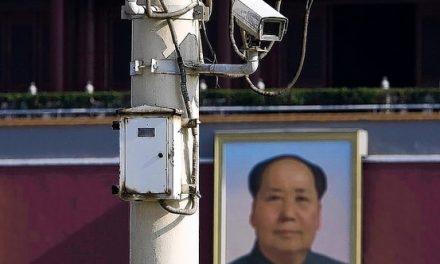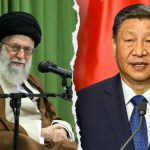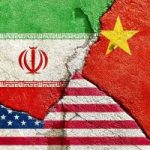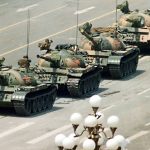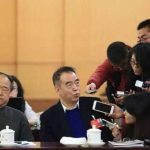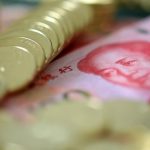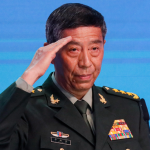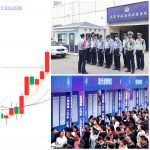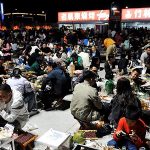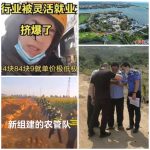By Bai Ding
On Tuesday, January 16 the Chinese National Bureau of Statistics released the country’s latest demographic figures. China’s total population was 1.409 billion in 2023, a decrease of 2.08 million people from 2022. In 2022, China’s total population declined for the first time since the last year of the Great Leap Forward famine in the late 1950s and early 1960s, when it declined by 850,000.
Data from the bureau show that the accelerated shrinkage of China’s total population in 2023 can be attributed to two trends. First, in 2023 China’s population death rate rose to the highest point since the Great Famine, reaching 7.87 per 1,000 people. The number of deaths throughout the year was 11.1 million, an increase of 6.6% from 2022. Second, the birth rate dropped to 6.39 per 1,000, the lowest point in recorded history, and the number of newborns was 9.02 million, a decrease of 5.7% compared with 2022.
Unlike in previous years, when Chinese state media published numerous warnings about the population crisis, after the release of the census figures this time they were unusually calm, and have rarely raised the topic of the population crisis. The semi-official media Caixin.com on January 24 published a commentary, “Is the Serious Decreasing Birthrate a Family Affair or a State Affair?”, pointing out that “the total fertility rate is around 1.0, which is less than half of the replacement level, and one of the lowest in the world.” However, the article focused on discussing the causes of low fertility and did not emphasize the crisis nature of the situation as before. The official media Sina Finance on January 18, 2024 also published a signed article, “How to view China’s population data in 2023?” the next day, which emphasized that “in the next 10 years, our country will still be in the demographic-dividend period, with the 30-40 and 50-60 year-old groups remaining at a high level, and labor resources are thus still relatively sufficient.”
Well, does China’s declining birth rate and a total population that is no longer growing in fact constitute a crisis?
Let us put aside the narrative language of the official media for the time being and compare a set of the simplest numbers. Currently, the four largest countries in the world by land area are Russia, Canada, the United States and China. Their land areas are, respectively, 17 million square kilometers, 10 million square kilometers, 9.8 million square kilometers and 9.6 million square kilometers. The populations of these four countries are 140 million, 37 million, 330 million, and 1.4 billion.
If you sort through these figures, you will find that if you add the populations of the United States and Canada, which are similar in area to China, and Russia, which is much larger, the total population is only slightly more than one-third of China’s current population. It can be seen that compared with these other three countries, China’s total population is not small.
So is China short of working-age people? Among these four countries, China’s working-age population accounts for a much higher proportion of the total population (similar to that of Russia) than in the United States and Canada. The above-mentioned Sina Finance article uses the narcissistic tone commonly used by Chinese official media to comment on China’s population data in 2023: “Before 2034, the proportion of the population that is young or middle-aged in mainland China will still be higher than in the United States, Europe, and Japan. Our country’s demographic dividend is still relatively dominant.” Therefore, compared with the other three countries, China does not have a shortage of working-age people.
But if we look at how difficult it is for young people to find jobs in China today and the embarrassing situation of a large number of middle-aged people over 35 who have retired early, you will understand that China has been vigorously creating this ideology that downplays any “China population crisis” for more than ten years. But it is another word game launched by the state media and its court scholars to fool the public.
China’s economy is indeed facing a crisis, and the crisis in turn is indeed related to China’s population. But this crisis is not the “population crisis” that the official media has been rendering as not actually a crisis.
So what then is the real crisis facing the Chinese economy? The real crisis of China’s economy is that even with such a large population, including many who are of working age, China can no longer satisfy the unbridled greed and demand for wealth of the Chinese Communist Party and the Chinese government.
The demand for wealth referred to here is not for funds required by the country to provide basic social security for the general public as the world understands that idea, because given China’s economic data the Chinese government’s expenditure on social security can be said to be minimal. The demand referred to here instead is for the huge amount of funds required to satisfy the greed of the CCP’s powerful elites and to maintain the CCP’s large-scale spending of money internationally. These two bottomless pits have become an unbearable burden for the Chinese people.
Before the launch of the One Belt, One Road Initiative in October 2013, the wealth created by the Chinese public was mainly used to support the powerful elite and the world’s largest civil service. But what the people need is not only the wages, benefits, medical care, and pensions of the powerful and the bureaucrats, but also the wages, welfare, medical care, and pensions of their children, other relatives, and related groups.
As the wealth of the country and its elites grew, China launched the One Belt, One Road initiative in 2013, injecting capital around the world in exchange for the recipient countries’ support for China in international affairs. Recipients include poor African countries, the former world hegemon Russia, and the wealthy Saudi Arabia, a Middle Eastern member of the Organization of Petroleum Exporting Countries. In return, these countries adopt a supportive or non-critical attitude toward China’s domestic human-rights policies and its external disregard for the international order.
How much money has China invested in the Belt and Road Initiative so far? Like all other Chinese data, the total amount is a mystery. The cumulative investment officially announced by China is in the hundreds of billions of dollars. (For 2013-2021, the cumulative direct investment was 213.8 billion U.S. dollars; in 2022, direct investment was 20.9 billion U.S. dollars.) But there are also Chinese official media reports that “the cumulative investment amount exceeds 1 trillion dollars.” This latter figure has been widely accepted by overseas media. In addition to these two sets of numbers, there are also rumors circulating on the Internet that private scholars estimate cumulative investment of 4 trillion or even 10 trillion US dollars. Like all other data, the Chinese government’s evasiveness about the amount of investment in the Belt and Road Initiative is the root cause of the orders-of-magnitude difference in measures of total investment.
Whatever the true figure, one thing is certain: China’s annual funding for the Belt and Road Initiative peaked in 2016 and is now shrinking sharply. This change is reflected in the dramatic changes in the attitude of recipient countries towards China. In the first few years of the implementation of the initiative, recipient countries were full of praise for it. However, in recent years, discordant voices by and even opposition to participation in the Belt and Road Initiative have begun to appear in these countries. In addition to their debt traps, the most outspoken reason for opposition is that the funds promised by China have been delayed.
The funds China uses to inject capital into the Belt and Road Initiative, and the wealth the CCP uses to support its bureaucrats and elites, all come from China’s “demographic dividend,” which actually arises from the economic advantage China gets from abusing human rights. What Chinese media and experts call the “demographic dividend” is actually the wealth of the elite and the government that has in fact been accumulated at the expense of the benefits that the majority of the people deserve. While all Chinese people are proudly following the trend and talking about this demographic dividend, only China’s bureaucrats and elites are really getting it. The vast majority of China’s population is just there to produce it. This is the “human-rights advantage” that Western countries have unanimously criticized for many years and on which China’s rise relies.
As an example of this “human rights advantage,” twenty years ago a poor China was waiting at the gates of the WTO to enter. Countries around the world have used economic pressure to try to force China to improve workers’ working conditions and implement a five-day work week, allowing the Chinese people to enjoy the same right to rest as people in other countries for the first time. Yet today, China uses its vast financial resources to suppress criticism of its lack of protection of human rights wherever it occurs. Today, no country will dare to offend China in order to help Chinese young people lift the burden of the 996 culture [where people are pressured to work nine AM to nine PM, six days a week]. As a result, the more powerful China becomes, the fewer countries and international organizations will dare to fight for the rights and interests of ordinary Chinese people, so the Chinese people will have less and less human dignity, and everyone knows it.
When China uses its limited resources to simultaneously support two baneful tasks, each of which on its own is unachievable, the country will certainly be strained. China’s current gross national output is no longer able to meet the dual needs of the Chinese government’s internal arrogance and its external spending on the Belt and Road Initiative.
This is actually China’s present economic crisis.
To resolve this crisis, we must either reduce total expenditure or increase total national wealth. The CCP will not take the initiative to curb the arrogance and excess of its powerful elite, nor is it willing to terminate the One Belt, One Road investment that still buys it international support. Therefore, the Chinese government’s only response to this crisis is to increase the total output of wealth by expanding the base of the working population and using low profits and high productivity to maintain its economic advantage. Encouraging childbearing and encouraging the elderly population to go back to work are parallel measures currently pursued by the Chinese government to expand its labor force.
These measures mean that the few public resources that are left will be competed for by more working people. Let’s use a real-life example so that everyone can understand this prospect: more and more unemployed people are turning to work as food-delivery riders to compete for ever-lower compensation. The life of these riders is becoming more and more difficult, but the leading food-delivery companies can rely on small profits per sale but quick turnover to ensure that their total profits continue to grow. This is the real-life version of China’s “human-rights advantage,” and China’s vast working population is the demographic dividend harvested by the country.
China is moving away from normal international society, so the labor benefits that the international community once brought to China’s working population (for example, the implementation of the five-day work system was one of the conditions that China had to meet to join the WTO) will gradually disappear.
In the coming years, without the supervision of the international community, China’s working population will face two difficult choices: accept increasingly harsh working conditions, including low compensation, or refuse to continue to be regarded as part of the demographic dividend that the Chinese government harvests.
his piece was translated from Yibao Chinese. If republished, please be sure to add the source and link https://www.yibao.net/?p=247711&preview=true before the text when reposting.
The views of the author do not necessarily represent those of this journal.


